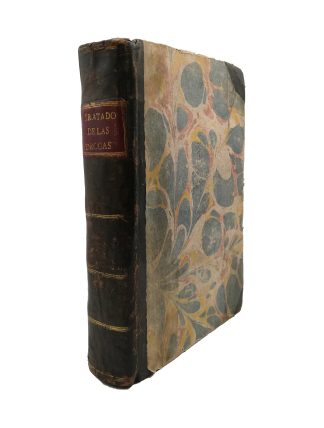ACOSTA, Cristóbal.
Tractado de las drogas y medicinas de las Indias Orientales con sus plantas debuxadas al biuo.
Burgos, Martín de Victoria, 1578£15,000.00
FIRST EDITION. 4to, pp. (xxiv) 448; 38 (ii). Roman and italic letter, woodcut floriated and historiated initials. T-p within woodcut architectural t-p incorporating the arms of Philip II of Spain (at head) and of the city of Burgo (at tail), large oval woodcut portrait of Acosta in prelims, 45 full-page woodcuts depicting trees, plants and herbs of the East Indies, 2 depicting elephants. T-p a bit dusty, light spotting throughout, heavier to a few ll., light waterstain to outer blank margins of one final gathering, tear to outer margin of one fol. just touching a side note in between lines. A very good copy in C18 half sheep, marbled boards, covers a bit worn at extremities, small hole at tail of spine, spine gilt ruled in compartments, gilt title label, a.e.r. Contemporary ms. ex libris “de la libreria de Don Fernando de Henao Monjaraz” to t-p.
First edition of this beautifully illustrated, influential work on medicinal plants of the East Indies. The splendid woodcuts are the first images of Indian flora printed in Europe, made from the author’s own accurate drawings.
A Portuguese doctor, naturalist and botanist, Cristóbal Acosta (c. 1525-1594) is considered a pioneer in the study of Indian plants and their use in pharmacology. He was born in Africa – in his works he calls himself ‘Africanus’ – possibly in Tangiers or Ceuta (Portuguese at the time) or in Cape Verde. Around 1550, after completing his studies in Arts and Medicine in Spain, he travelled as a soldier to India. In the city of Goa, he met the great physician and naturalist García da Orta, the first European to describe the indigenous drug plants of India in his ‘Coloquios dos simples’. Appointed personal physician of the viceroy Luís de Ataíde, Acosta returned to Goa in 1568 and spent many years studying the local flora and collecting botanical specimens from various parts of India. His ‘Tractado de las drogas’ is an illustrated adaptation of Da Orta’s earlier treatise, with a series of interesting additions of his own. Acosta states: “The learned Dr. Orta has written with curiosity and diligence, but he has used reports, whereas I have set down what I have seen with my own eyes and depicted from life”.
In this work, Acosta describes a total of sixty-nine botanical species for medicinal use. Each entry contains an attractive illustration, a general description of the plant, its morphological elements (root, stem, leaves, flowers, fruits, seeds), geographical environment, therapeutic and dietary properties, and finally commercialization and industrial uses. References to the great classical naturalists of Greco-Latin antiquity are combined with the traditional guidelines of Galenic therapy. Among the species described, we find: nutmeg, tamarind, coconut, ginger, cardamom, mango, rhubarb, and asafoetida. Some of them, such as cinnamon, black and white pepper, cloves, nutmeg or opium had not been mentioned by da Orta. The author also depicts a few native American plants, including the pineapple, amber, rubber tree, sugar cane and the “Indian fig” of Peru. At the end, there is a fascinating section titled ‘Tractado del Elephante y de sus calidades’, that is a ‘treatise on the elephant and its qualities’ – this is considered the first monograph on the Indian elephant printed in Europe. It includes a realistic drawing of an elephant leaning against the trunk of a coconut palm and another of a war elephant with a castle on its back. Acosta’s ‘Tractado’, is also among the first works to record words from the basque language.
The ex-libris of “Don Fernando de Henao Monjaraz” appears on several volumes held in the National Library of Madrid and in other Spanish libraries (Real Academia de la Lengua, Biblioteca de Palacio). A bibliophile and owner of a large book collection, Don Fernando is identified by most scholars as a relative of the Spanish poet and nobleman Gabriel de Henao Monjaraz (1589-1637) – possibly his son, but it must be noted that his father and brother had the same name. He might be the same Don Fernando de Henao Monjaraz, noble knight of Santiago, who enrolled in the ‘Escuela de Cristo’ (a catholic institution for secular priests) in 1659 and died in 1698.
USTC 334051; Graesse I, p. 15; Alden 578/19; Pritzel A31; BM STC 16th century Sp. p. 1; Maggs 4; Palau 1962, “Libro estimado”. Not in Adams.In stock









